We’ll talk about SaaS content writing, but first let me drop a scenario at your doorstep:
Let’s say there’s a guy named Kofi.
Kofi runs an accounting firm — a small one, but it’s growing fast, which means he and his team are pulling late nights, elbows deep in spreadsheets, invoices, and hours logged.
And this is where things start to fall apart.
Time tracking. It’s a mess.
Last week, the firm overbilled a major client.
The week before, they underbilled.
There’s a bottleneck in the workflow, and it’s costing them both time and money.
Kofi’s team has tried Excel sheets, calendar reminders, even some free apps, but they’re all band-aids on a bullet wound.
It’s clear now: Kofi needs something robust. He needs time tracking software.
Modern problems require modern solutions.
So, like any modern-day problem-solver, Kofi opens his laptop, hits up Google, and types in, best time tracking software for accountants.
And boom. He’s hit with a tidal wave of results:
He’s been searching for a few minutes — sifting through software companies that all say the same thing:
“Great for freelancers.”
“Perfect for corporations.”
“Built for teams of all shapes and sizes.”
Except… none of them are actually built for him.
Not a word about billable hours.
Nothing on audit trails.
So, he keeps scrolling. Frustrated. On the verge of giving up. Then, he sees it.
A time tracking software that doesn’t scream “We’re for everyone!” but quietly whispers, “Hey, accountants… this one’s for you.”
Their blog? Spot on.
They don’t waste time with abstract promises.
Instead, they talk about his pain points.
- The headache of tracking billable hours.
- The chaos of compliance and regulations.
- The yearly tax-season scramble that turns accountants into sleep-deprived zombies.
They lay it all out — plain and simple.
Here’s how we handle it.
Here’s how we integrate with QuickBooks.
Here’s how you keep every project and every client crystal clear.
Suddenly, Kofi’s not just looking at software anymore. He’s looking at a solution made for him.
That’s the moment Kofi stops scrolling and buys.
Because their content doesn’t try to be everything to everyone. It gets specific and speaks directly to the people it’s built for.
And in a crowded SaaS market, that’s what cuts through the noise.
The companies that win? They don’t talk around the problem. They solve it.
How to write great SaaS content
The lesson here is simple: to write great SaaS content, you’ve gotta know the product like the back of your hand.
Not the “I skimmed some blog posts” kind of knowing, but the “I’ve had one-on-ones with the people behind the curtain” kind of knowing.
And who are those people?
- The engineers — the ones who built the software and can tell you why that one feature everyone keeps raving about even exists.
- The product managers — they’re the bridge between the tech and the customers, the ones who know how every feature solves a specific problem.
- The founders — they’re the visionaries who saw the gap in the market, the ones who can tell you the “why” behind the product.
- And let’s not forget the sales team — they’re on the front lines, hearing the real reasons prospects say “no” or “tell me more.
These people are what I like to call the minds behind the product.
The real magic happens when you know your customers’ pain points like they’re your own.
You’ve got to get into their heads. Understand what’s keeping them up at night. What’s making their workday feel like a grind. And why the tools they’ve tried so far just aren’t cutting it.
You need to feel that frustration — that gnawing, relentless feeling when they can’t get the job done right. And that frustration should drip from every word you write.
Because here’s the truth: Sure, your product is the solution.
But that doesn’t mean a damn thing if you don’t fully understand the problem it’s solving.
The pain point and the product are two sides of the same coin. Yin and yang. Can’t have one without the other.
When you lean into their struggles, when you truly get it — that’s when your words stop sounding like a sales pitch and start feeling like a lifeline.
And that’s what great SaaS content is all about.
In this guide, I’ll show you how to do it. Step by step.
Let’s dig in.
SaaS content writing tip #1: use comparison pages
Here’s why competitor comparison content works like a charm:
When someone Googles a keyword like asana vs trello or hubspot vs salesforce, they’re ready to make a decision.

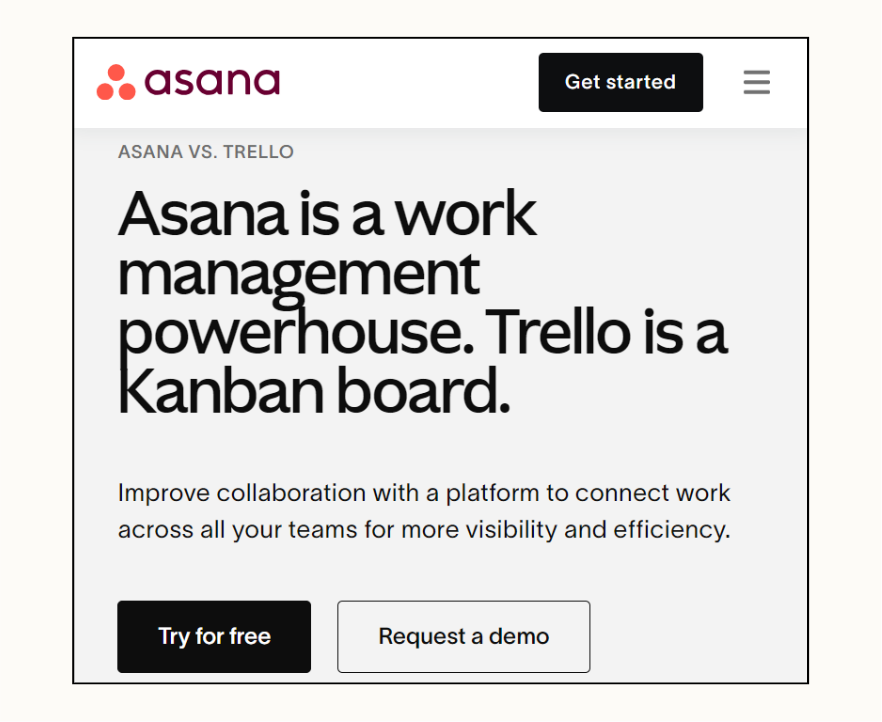
They’ve already got one foot in the door, wallet half out, actively hunting for answers. They don’t just want to know which tool to pick — they want to know which one’s actually going to fix their damn problem.
Your job? Hand them those answers on a silver platter and make it painfully obvious why your SaaS is the right call.
Comparison pages do that. They lay it all out — side by side, feature for feature — and put things into perspective. But here’s the kicker: If you think a lazy feature list will cut it, think again.
No one cares that you’ve got 17 features and your competitor has 15.
People care about one thing — whether or not your product solves their problem better than the one they’ve already got.
Make that clear, and the decision becomes a no-brainer.
But here’s the snag — not everyone’s searching for you by name.
You’re not HubSpot. You’re not Asana. You’re not Trello. And if your product isn’t a household name, guess what?
They’re not typing “Your Product vs. Big Competitor” into Google.
So what do you do?
You pivot. You go after the keywords your potential customers are actually using. The “alternatives to” and “better than” searches.
And that’s how you win the comparison game.
How to target alternative keywords
Alternative keywords are search terms that people use when they’re not comparing two products head-to-head, but instead, they’re looking for replacements.
Think of search terms like trello alternatives or hubspot alternatives.
These folks aren’t Googling your product just yet. But they’re fed up with what they’ve got — and they’re sniffing around for something better.
This is your way in.
These keywords slide you into the conversation, even if your SaaS brand isn’t exactly a household name.
And the best part? They’re aimed at people already standing at the edge of the plank, ready to bail on the big players.
All they need is one good reason to jump.
Your job? Show them why you’re the smarter choice. The better boat.
Here’s how to write a great comparison page that hits those “alternative” keywords — and makes your case crystal clear:
1. Identify your ideal customer’s frustrations:
Start by asking yourself this: Why are they even looking for an alternative in the first place?
What’s got them fed up with Trello, HubSpot, or whatever tool they’re using right now?
Is it the sky-high pricing? Missing features? Garbage customer support?
Figure that out — and then hit those pain points head-on.
If their current tool is leaving them feeling ignored, overcharged, or stuck, that’s your way in.
Speak to their frustrations. Show them you get it. And then show them why you’re the better way forward.
2. Pick the right alternative keywords:
Use tools like SEMrush or Ahrefs to dig into search terms that people are using when they’re fed up with your competitors.
Most alternative keywords look like this:
- <Competitor> alternatives (e.g., trello alternatives)
- Best <product category> alternatives (e.g., best crm alternatives)
- Best software for <specific use case> (e.g., best project management software for small teams)
These are the search terms you want to hit.
These keywords help you catch people who are ready to move on and are looking for something better.
Read my SaaS SEO guide to learn more about finding SaaS keywords.
3. Address competitor pain points early:
Once you’ve nailed your keywords, don’t beat around the bush.
Address why people might be searching for alternatives right off the bat.
If the competitor’s product is overpriced, too complicated, or lacking features, point that out.
You want your readers to feel like you get their frustrations and have a solution.
4. Highlight unique strengths:
You’re not trying to be the next HubSpot or Asana — you’re offering something they can’t.
Maybe your pricing is more accessible, your interface is simpler, or your features are tailored to a specific audience.
Whatever it is, highlight what makes your product the smart alternative.
This is where you shine.
5. Use honest comparisons:
Be upfront about what your product does differently.
If the competitor has certain strengths that you don’t, that’s fine — just be honest about where your product excels.
If you’re more affordable but with fewer bells and whistles, say so.
People appreciate transparency, and that’s how you build trust.
The anatomy of a good comparison page
Once you’ve got your keywords locked down, it’s time to build a persuasive comparison page.
Here are the key elements:
1. Headline:
Make your headline specific and clear.
- Good: Trello Alternatives
- Better: Trello Alternatives: 5 Better Tools for Remote Teams
Specificity grabs attention.
2. Comparison table:
Start with a table that compares features, pricing, and customer support.
Keep it simple but impactful.
Make sure your product stays in view, and if you’re comparing multiple products, allow for side-scrolling.

3. Detailed feature breakdown:
Get specific. Dive deep.
Break down exactly how your product stacks up feature by feature. But don’t stop there — anyone can make a list.
What matters is the why.
Why does this feature matter to your customer? How does it make their life easier? Save them time? Solve a headache they’ve been dealing with for too long?
Paint the picture.
Make it crystal clear that your features aren’t just nice to have — they’re the reason your product gets the job done better than the competition.
4. Pricing comparison:
Be transparent about pricing, and don’t be afraid to call out your competitors if they’re more expensive without offering more value.
Explain the ROI your product deliver
Be upfront about your pricing. Don’t dance around it.
And if your competitors are charging more without delivering more? Call it out. Loud and clear.
Because price only matters when there’s no value to back it up.
Show them exactly what they’re getting for their money. Lay out the return on investment. Make it undeniable that your product delivers more for less.
When you’re transparent about pricing — and confident in your value — you build trust. And trust? That’s what gets people to buy.
5. Customer testimonials:
Nothing sells a product like happy customers.
If you’ve got testimonials from people who’ve switched over from a competitor, use them.
These are your strongest pieces of social proof, especially if they call out the exact reasons why your product is a better fit.
In my SEO and UX guide, I mentioned how I was impressed with the way HelpCrunch’s comparison pages used testimonials to nudge users to switch from their competitors.
Here’s an example of how they used testimonials to steal users from Intercom:
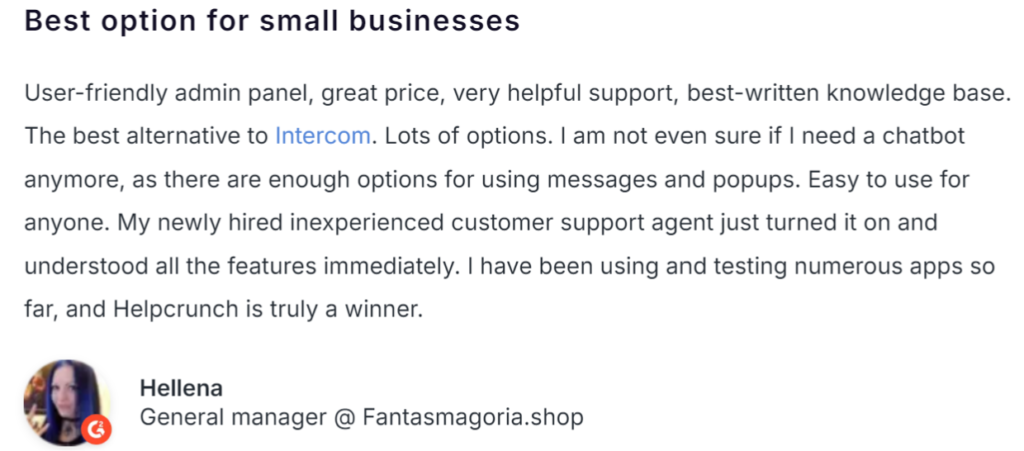
7. Call to action (CTA):
Don’t leave them hanging.
They’re already curious. They’re already looking for something better. Your job is to nudge them over the edge.
Tell them exactly what to do next — sign up for a demo, start a free trial, hop on a call with sales. Whatever the next step is, make it loud and clear.
No fluff. No second-guessing.
SaaS content writing tip #2: Job-to-be-Done keywords
These aren’t your run-of-the-mill, feature-stuffed keywords. Nope.
They’re the kind of words your customers punch into Google at 2 AM, half-crazed, caffeine-fueled, and desperate for answers.
Because they’re not searching for a product. They’re searching for a fix. A way to hit their goals. A way to make the frustration stop.
That’s where these keywords come in — rooted in real problems, real tasks, and real late-night searches.
Let’s break it down.
What are Job-to-be-Done keywords
Your customers don’t buy products. Hell, they don’t even buy features. They hire solutions.
Think about it — no one’s out here losing sleep over finding a CRM with the most bells and whistles.
What keeps them up at night is their challenges:
Missed deals. Sales teams that can’t close.
They aren’t looking for a CRM. They’re looking for a life raft. The features are just the oars that get them to shore.
When you write content that speaks to those jobs — the real, human problems your product solves — you’re no longer selling software. You’re solving pain points.
And that’s what lands deals.
Stop talking about what your SaaS does. Start talking about what it does for them.
How to write content for Job-to-be-Done keywords
So, how do you actually write content that hits these keywords — the kind that grabs people when they’re ready to switch?
Here’s your playbook. Step by step:
1. Identify the job your product is being hired to do:
Before you can write content that actually connects, you’ve got to know why people are turning to your product in the first place.
And no, it’s not about surface-level stuff.
If you’re selling a project management tool, the job isn’t just “managing projects.” That’s too broad. Too boring.
The real job? It might be “cutting down on wasted time in meetings” or “making remote collaboration less of a dumpster fire.”
To find those jobs, you’ve got to talk to your customers. Ask them the real questions:
- What problem were you trying to solve when you started looking for a tool like ours?
- How does our product make your life easier?
- What’s the main thing you actually use our product for?
Get specific. Drill down.
Because once you know the jobs they’re hiring your product to do, you’ll know exactly what to write about — and how to make it hit home.
2. Frame your content around the job, not the features:
Once you know what job your customers are hiring your product to do, it’s time to create content that speaks directly to that job.
Here’s what that looks like:
Let’s say you sell email marketing software like MailChimp and DotDigital do.
You could write a post called “Top 10 Features of Our Email Marketing Tool.”
That might grab the attention of someone who’s still exploring their options, but it’s unlikely to connect with someone actively searching for a solution to a problem they’re facing right now.
Now, try this instead:
How to double your sales with personalised campaigns
That speaks directly to someone trying to solve a specific problem — bumping up sales through email.
They’re not just interested in the software’s features; they want to know how it will help them achieve their goal.
See the difference?
The first example is about what your software has.
The second is about what your software does to help them solve their problem.
It’s all about addressing the job they’re trying to get done — in this case, increasing sales with better emails.
The more specific and outcome-focused your content is, the more likely you’ll attract the customers who are ready to take action.
SaaS content writing tip #3: use stories and case studies
Talking about what your product could do is nice. But showing what it’s actually done?
That’s what makes people sit up straight and pay attention.
Enter: customer stories and case studies.
Think of these like mini-movies where your product is the hero that swoops in and saves the day.
The struggling company is the relatable protagonist.
And the job they’re trying to get done? That’s the conflict.
These real-world examples hit different because they make your product real.
For example, let’s say you have a customer who used your email marketing software to recover lost revenue through abandoned cart emails. Don’t let that story get buried under a bullet point like “automated cart recovery” on your features page.
Turn it into a story.
Write a case study titled:
How XYZ store recovered $50,000 in lost revenue using automated cart emails
Now your reader isn’t just guessing at what your product might do. They’re seeing it in action. They’re picturing themselves as the next success story.
And that’s powerful.
Look at how MailChimp uses stories to show off their software:
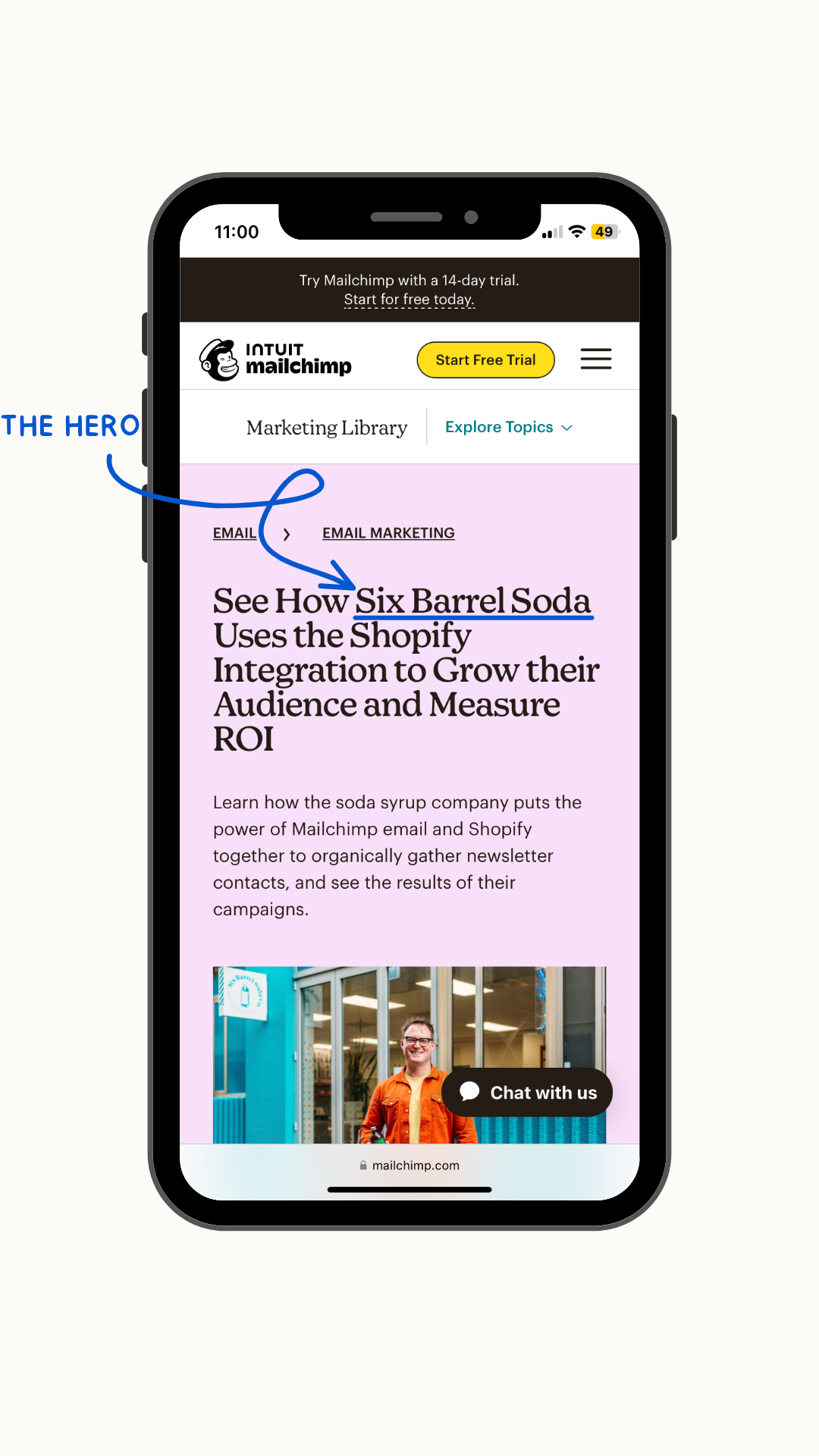
Because at the end of the day, people don’t buy possibilities — they buy proof.
Why customer stories work
People love stories.
And more importantly, people love stories they can see themselves in.
When you share how your product solved a real problem for a real person or company, you’re giving your audience more than a sales pitch. You’re giving them a mirror.
It’s no longer about abstract features or fancy functions.
It’s about something far more powerful:
“If this product helped them, it can help me too.”
The more your audience sees their own struggles and goals reflected in your customer’s success, the more they’ll trust your product to be their solution.
And trust? That’s the spark that turns readers into buyers.
1. Focus on the Job to be Done:
Every customer story needs to center around a specific job your product was hired to do.
Did your tool help a company boost customer retention? Great. Highlight that.
Get specific. Show measurable impact. Because nothing sells your product better than proof that it delivers real results.
2. Show the before and after:
A great customer story isn’t just about the win — it’s about the journey to get there.
Start by painting a clear picture of where your customer was before your product stepped in.
- What problem were they dealing with?
- How was it dragging their business down?
- What frustrations were keeping them up at night?
Then, show the transformation.
How did your product solve that problem? What measurable impact did it have?
The more detailed, the better.
You’re showing your reader what their before-and-after could look like. And that’s what makes them think: “I want that for me.”
3. Give quantifiable results:
Words are nice, but numbers? Numbers sell.
Include real data that shows exactly what your customer achieved with your product.
Whatever the win, make it measurable.
Because these hard results? They’re what take your case study from a nice story to undeniable proof that your product delivers.
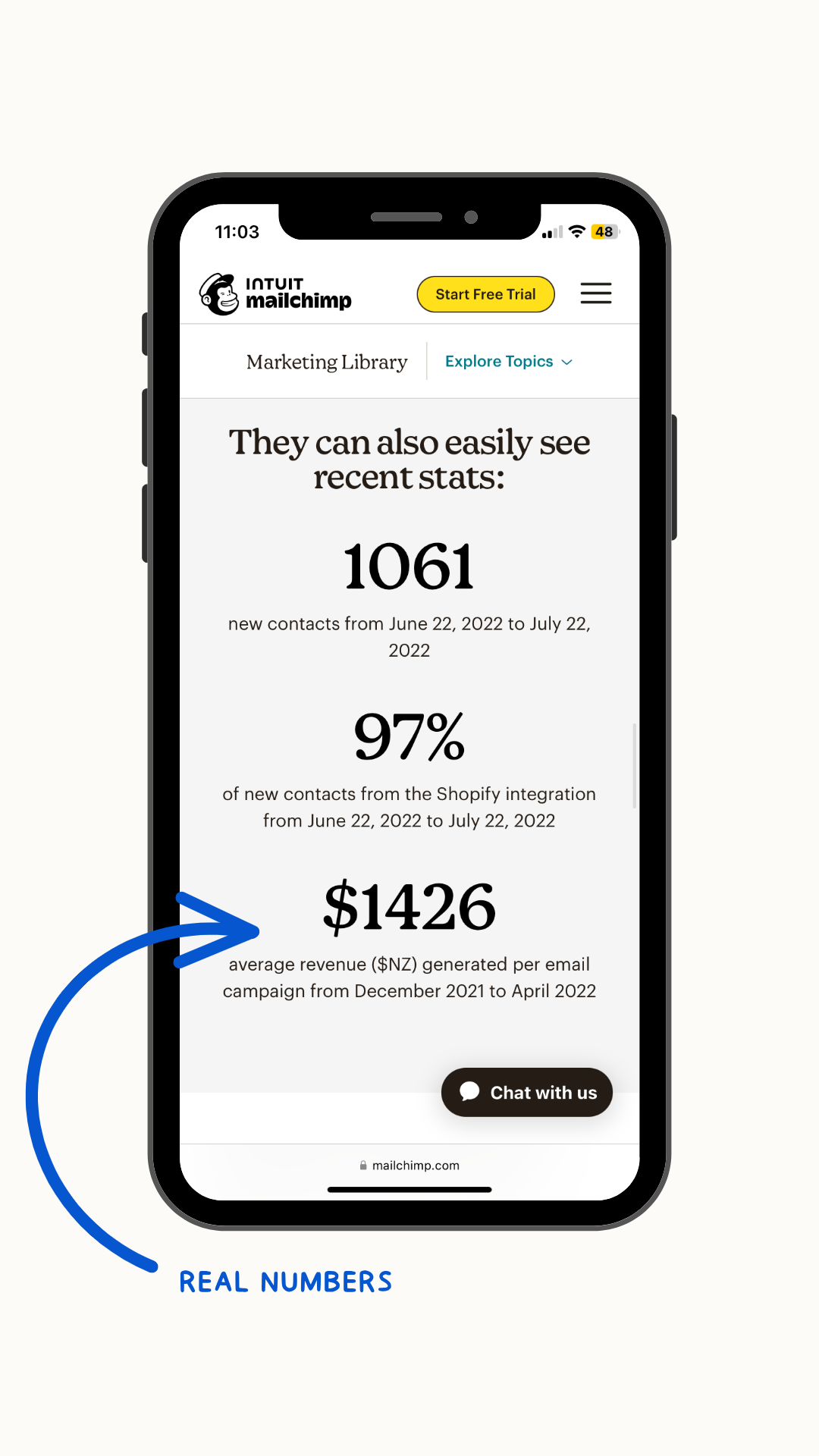
4. Let your customers do the talking with quotes:
A powerful story hits even harder when it’s told in your customer’s own words.
Include direct quotes that capture their experience with your product. Real, raw, and relatable.
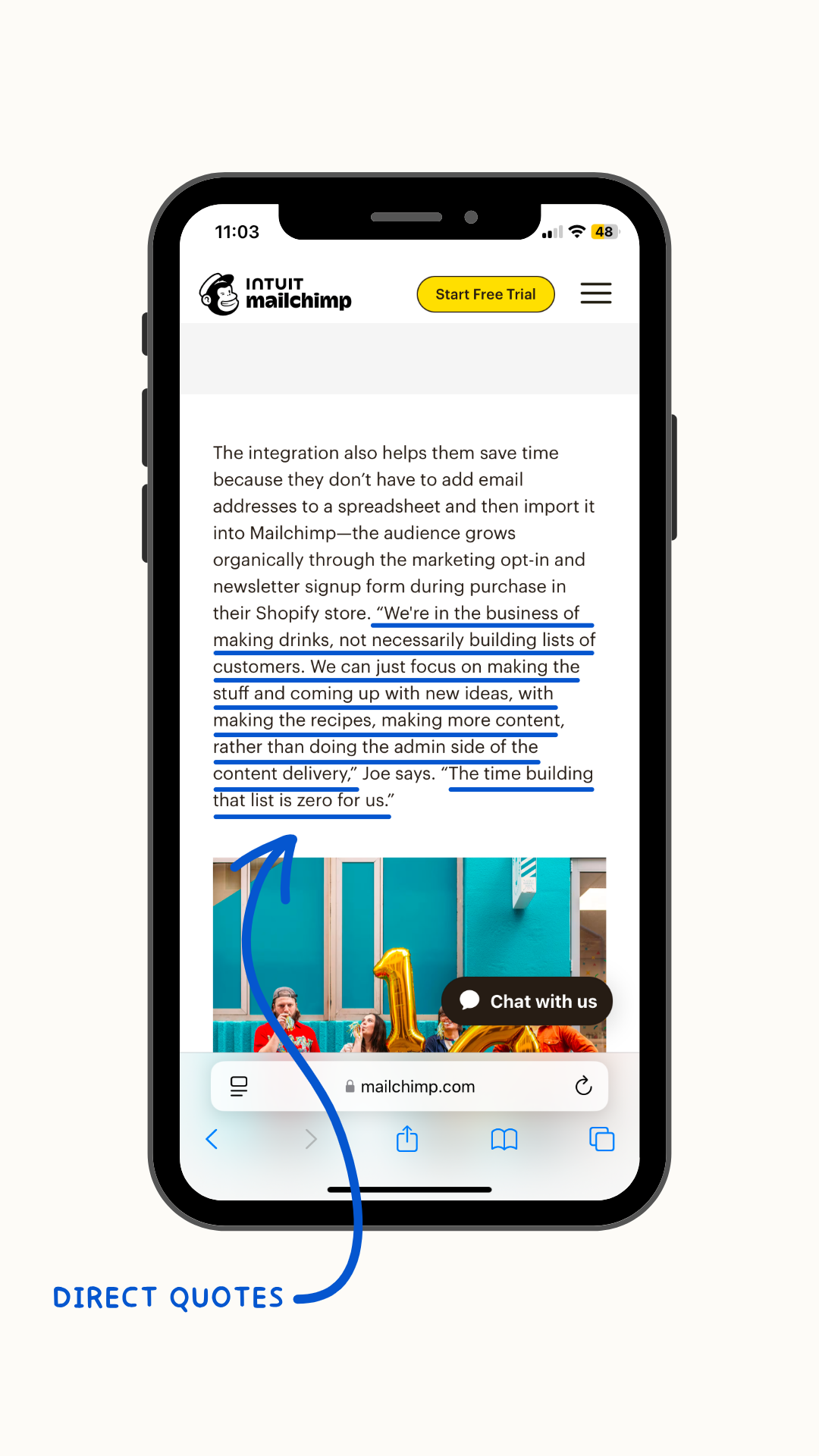
These quotes make your case study feel real. They humanise the success story.
And more importantly? They build trust.
Because at the end of the day, nothing sells better than hearing: “It worked for me — and it can work for you, too.”
5. Make it visual:
A great case study isn’t just about words on a page — it’s about creating something people feel.
Add images of dashboards, charts that highlight results, or screenshots of specific features that made a difference.
Even better? Include a video testimonial if you can.
Because here’s the truth: Numbers are powerful, but seeing is believing.
Visuals make the story more engaging, easier to digest, and — most importantly — more memorable.
And a memorable case study? That’s the one that sticks.
When you weave customer stories and case studies into your content, you’re doing more than just pitching your product — you’re proving its value in the real world.
You’re backing up your claims with real-life results. You’re giving potential customers something solid to trust.
They don’t have to sit there wondering if your product will work for them — they can see it, plain as day. In black and white. With hard numbers to match.
And that’s when your SaaS product stops being just another option in a crowded market.
It becomes the solution they’ve been searching for. The thing that makes them say: “This is exactly what we need.”
That’s all, folks. That’s all he wrote.
Thanks for reading.
